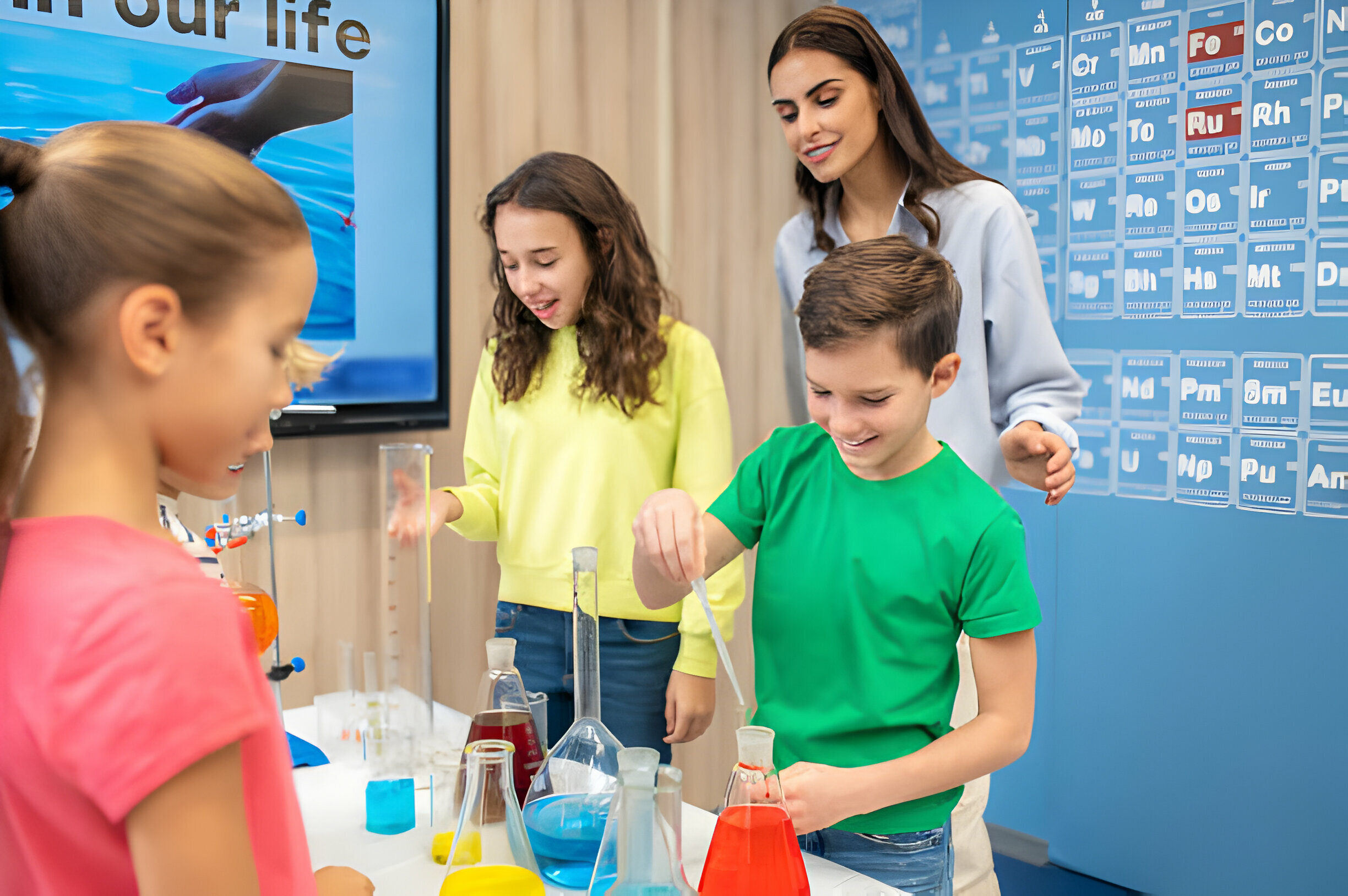Embark on a scientific adventure like never before with Next-Level 6th Grade Science Fair Projects. Dive into the realm of discovery, where chemical reactions dance, balloons soar, and magnets come to life. Unleash your curiosity as you explore the wonders of electricity, earth sciences, and environmental impacts. From crystal gardens to solar-powered robots, each project offers a chance to unravel the mysteries of STEM fields while honing your skills and knowledge. Get ready to elevate your science fair game!
Chemical Reactions
You can investigate the differences between baking powder and baking soda through exciting chemical experiments. Mixing them with various substances can lead to colorful reactions. Explore creating edible polymers by combining specific ingredients. Witness the magic of a carbon snake forming when burning a mixture of baking soda and sugar. Test the tensile strength of different materials by conducting simple experiments at home. For a fun activity, try making a baking soda boat that can move in water due to the chemical reaction happening beneath it. These hands-on projects will not only teach you about chemistry but also spark your curiosity for more scientific explorations.
Physics and Motion
Explore the principles of physics and motion through engaging experiments and hands-on activities. Launch balloon rockets to grasp laws of motion or experiment with gummy bears in various solutions to learn about molecules. Dive into constructing motorized characters powered by homopolar motors for a fun dance party experience. Challenge yourself by balancing a pen using magnetism, honing your science skills in the process. Take it up a notch with WiggleBots, delving into robotics and electrical energy concepts through exciting projects. These activities will not only enhance your understanding of physics but also spark your curiosity for more discoveries in the world of motion and energy.
Electricity and Magnetism
Delve into the fascinating realm of electricity and magnetism, discovering how circuits can be embedded into holiday greeting cards to study the flow of electricity. Magnetic levitation, electric circuits, magnetized objects, energy manipulation, and magnetic fields all play crucial roles in understanding this captivating field. By experimenting with these concepts, you can witness firsthand the interplay between magnets and electricity in various applications.
| Electricity and Magnetism Concepts | Description |
|---|---|
| Magnetic Levitation | Levitating objects using magnetic fields. |
| Electric Circuits | Path for electrical current to flow. |
| Magnetized Objects | Items made magnetic through exposure to a magnetic field. |
| Energy Manipulation | Controlling energy transfer within systems. |
| Magnetic Fields | Area around a magnet where magnetic force is exerted. |
Earth Sciences
In Earth Sciences, you can model seafloor spreading using paper and cardboard to simulate tectonic plates. Understanding rock erosion is vital in comprehending how landscapes evolve over time due to natural forces. Crystal growth showcases the intricate patterns formed by minerals under specific conditions, offering a glimpse into geological processes. Plant behavior not only impacts ecosystems but also plays a role in soil stabilization and nutrient cycling, influencing the environment around them. Exploring seafloor spreading sheds light on plate tectonics and the movement of continents across Earth’s surface. Investigating tsunami impact helps us prepare for and mitigate the devastating effects of these powerful ocean waves on coastal communities.
Environmental Science
Learn about the impact of seafloor spreading and earthquakes on rock formation in Environmental Science projects. In this field, you’ll delve into pollution prevention, climate change, renewable energy, ecosystem restoration, and sustainable living. Through studying seafloor spreading and earthquakes, you can understand how these natural occurrences shape our planet’s geological features and influence the environment. Moreover, by exploring topics like pollution prevention and climate change, you’ll grasp ways to mitigate human impact on ecosystems. Renewable energy sources offer hope for a cleaner future while ecosystem restoration projects aim to heal damaged environments. Embracing sustainable living practices ensures a harmonious coexistence with nature. Engaging in Environmental Science projects will equip you with valuable insights into preserving our planet for generations to come.
Fruit Ripening and Oil Spill Cleanup Projects
Let’s experiment with ways to ripen fruit quickly without losing flavor in Fruit Ripening and Oil Spill Cleanup Projects. Quick ripening methods can help maintain the delicious taste of fruits while speeding up the ripening process. When it comes to oil spill impact, understanding cleanup methods is crucial for wildlife rescue and ecosystem preservation. By exploring effective cleanup techniques, we can minimize the devastating effects of oil spills on marine life and habitats. It’s essential to prioritize flavor preservation when experimenting with fruit ripening, ensuring that the fruit remains tasty despite accelerated ripening processes. Consider innovative approaches that balance quick ripening with maintaining the natural flavors of fruits to create a successful project in both areas.
Water Filtration and Earthquake Science
Water filtration systems can vary in effectiveness when providing safe drinking water, while engineering solutions for earthquake zones require innovative approaches to minimize structural damage. Understanding soil composition is crucial for earthquake preparedness, ensuring structures have the necessary stability. Water purification plays a key role in disaster-prone areas, where access to clean water may be compromised. Maintaining structural integrity is essential in earthquake science projects to prevent catastrophic consequences. Filter efficiency is paramount for effective water filtration systems, removing contaminants and pathogens from water sources efficiently. By considering these factors, you can develop comprehensive solutions that address both clean drinking water needs and structural resilience in earthquake-prone regions.
Gardening and Ant Control Projects
Understanding how hydroponic gardening compares to traditional methods can lead to more sustainable and efficient ways of growing plants. When it comes to pest control in gardening, organic methods are gaining popularity for their environmentally friendly approach. Ant behavior can disrupt plant health, but natural solutions like diatomaceous earth or vinegar can deter them without harming your plants. By focusing on organic gardening practices and incorporating natural solutions, you not only promote plant health but also contribute to a healthier ecosystem overall. Consider exploring the benefits of companion planting or using neem oil for pest management to create a harmonious balance between your garden and its inhabitants.
Natural Disaster Simulation Projects
In a natural disaster simulation project, you can propose innovative ways to protect communities and reduce damage caused by tsunamis. By focusing on emergency response, disaster preparedness, evacuation planning, community resilience, and risk assessment, students gain valuable insights into handling catastrophic events effectively. Consider developing strategies for swift emergency response procedures, comprehensive disaster preparedness plans, efficient evacuation planning routes, fostering community resilience through education and resources, and conducting thorough risk assessments to mitigate potential dangers. Engaging in these aspects not only enhances your scientific knowledge but also equips you with critical skills to make a positive impact during challenging times.
Chemical Experiments
Let’s dive into some cool chemical experiments using everyday household items! Have you ever wanted to witness colorful reactions, create edible polymers, ensure fire safety, experiment with invisible ink, or simulate volcano eruptions? With simple ingredients like baking soda and vinegar, you can observe vibrant color changes that make chemistry exciting. Edible polymers can be crafted from ingredients found in your kitchen, offering a hands-on experience of polymerization. Remember to prioritize fire safety when conducting experiments involving heat or flammable materials. Delve into the world of secret messages by making invisible ink using lemon juice or milk. Lastly, simulate explosive volcano eruptions with baking soda and vinegar for an engaging experiment that brings science to life!
Breakfast Cereal and Coin Cleaning Projects
For the breakfast cereal and coin cleaning projects, experiment with household items to clean oxidized coins. Are you ready to delve into some science fun? Here are five handy tips for your project:
- Breakfast cereal iron content analysis: Explore how different cereals can help in extracting iron to clean those tarnished coins effectively.
- Coin tarnish removal techniques: Try out various methods such as using baking soda or lemon juice to see which works best on your coins.
- Fruit ripening methods comparison: Draw parallels between fruit ripening techniques and coin cleaning processes for a unique perspective.
- Oil spill impact assessment: Understand the importance of thorough cleaning by comparing it to the meticulous process of removing tarnish from coins.
- Water filtration effectiveness study: Just like filtering contaminants from water is crucial, so is removing grime from old coins; compare the two processes for a deeper understanding.
Produce Power and Bridge Engineering Projects
Are you interested in discovering which produce best powers a clock for your project on Produce Power and Bridge Engineering? When delving into this exploration, you’ll uncover the potential of renewable energy sources from fruits and vegetables. Consider how structural integrity plays a crucial role in bridge design while incorporating alternative power sources for sustainability. By focusing on energy efficiency, you can enhance your understanding of how different types of produce can be utilized to generate power effectively. This project not only highlights the innovative use of natural resources but also emphasizes the importance of balancing functionality with eco-conscious practices in engineering projects. Get ready to unlock the potential of produce power while enhancing your knowledge of bridge design principles!
Motor Projects
Moving on from producing power and bridge engineering, let’s delve into motor projects. You can now assemble simple motors and even build tiny dancers that come alive with movement. It’s a fantastic way to connect with energy conservation principles while having fun experimenting with motion. Additionally, you have the opportunity to explore sound through motors and get creative by incorporating genetic diversity concepts into your projects.
- Construct tiny dancers for a unique display of motion.
- Experiment with simple motors to understand their functionality.
- Explore how motors contribute to energy conservation efforts.
- Dive into sound exploration by integrating motors into audio projects.
- Incorporate genetic diversity ideas in motor-related experiments for a holistic scientific experience.
Candle Combustion and Energy Conservation Projects
Exploring how room temperature affects candle burn rate can be a fascinating experiment in our Candle Combustion and Energy Conservation Projects. By observing the impact of room temperature on the candle’s burn rate, you can gain insights into energy conservation analysis. Not only does this project allow you to measure the candle burn rate accurately, but it also sheds light on idle device energy waste in your surroundings. Additionally, delving into basic sound exploration while conducting this experiment can enhance your understanding of how various factors interact within a confined space. So, grab your materials, set up your experiment, and get ready to uncover the relationship between room temperature and candle burn rates in this engaging science endeavor!
Sound and Genetics Projects
Delve into basic sound exploration while creating DNA gene bracelets to discuss genetic diversity. By combining these projects, you can delve into the fascinating world of genetics and sound simultaneously. Here are some key aspects to focus on:
- Genetic diversity bracelets
- Sound amplification techniques
- DNA gene exploration
- Taste perception illusions
- Gum flavor longevity
Experimenting with sound and genetics not only provides an engaging learning experience but also opens up discussions about the intricacies of genetic variation and the importance of preserving it. Through hands-on activities like creating DNA gene bracelets and exploring sound amplification, you can gain a deeper understanding of these concepts while having fun in the process.
Chemical Reaction Experiments
Let’s mix baking powder and vinegar to observe an acid-base reaction in action. It’s fascinating how the combination creates a fizzy effect due to the release of carbon dioxide gas. You can also delve into color change reactions by experimenting with different substances that alter hues when mixed. If you’re feeling adventurous, try out carbon sugar experiments by burning a mixture of baking soda and sugar to create a giant carbon sugar snake. Additionally, exploring plastic polymerization studies can lead to making milk-based plastic at home for unique creations. To add some fun, analyze skateboard wheels for their material strength or engage in a baking soda boat race for a competitive twist on science experimentation.



